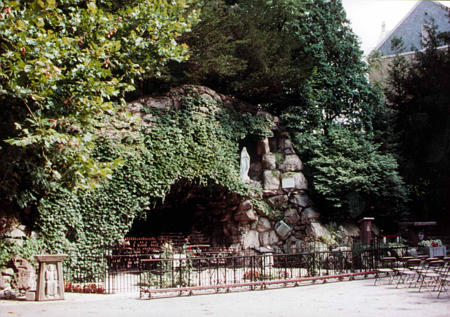
A Cave of Candles / by Dorothy V. Corson

Chapter 25a
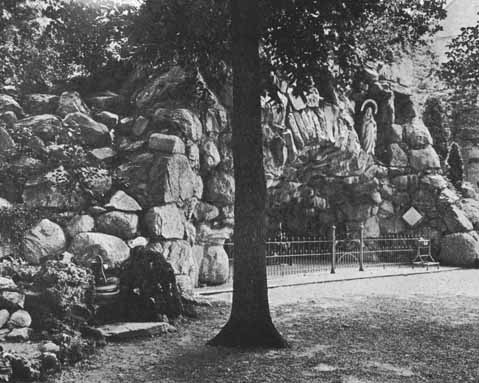
Ongoing News of Newly Erected Grotto
There are a few other entries in the 1896 Annals, near the time of the dedication, describing subsequent pilgrimages made to the newly erected Grotto of Lourdes at Notre Dame.
The South Bend Tribune capsuled one of those visits:
The annual pilgrimage from Kalamazoo to Notre Dame took place today. Two trains of 10 coaches each, all loaded with people came over and many of them attended services in the church of Sacred Heart. After services the excursionists visited the university and points of interest about the city.(310)
The Kalamazoo Augustinian also details this 1896 trip and mentions:
At Dowagiac Fr. Joos got aboard with a number of Indians which was an event of the trip. . . . Strangers from a distance were also on the train, even as far away as Detroit, was well represented. . . . The Grotto was a beautiful surprise. Although much had been promised, more than what was promised was realized. It is a wonderful creation. It was the favorite spot for the pilgrims throughout the day. The spring was tested and more than one favor was received.(311)
A year later, in August of 1897, further work on the Grotto is described in the Scholastic:
The grotto is still unfinished. After it was found some months ago that the water got through it, the mound at the rear was taken away and the back newly cemented, covered with asphalt paper and tarred. Rain cannot penetrate it now, but the rear is still unfinished. The erection of a new mound would be a welcome relief from the desolate blackness that now confronts the visitor.(312)
Again, the ending of Father Maguire's letter touches on this subject. He ends his letter with this last sentence:
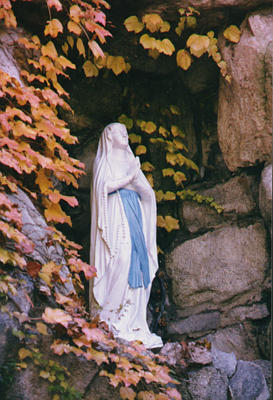
The grotto was begun and completed in 1896 but each year little touches here and there have made it the beauty spot it is today, a place worthy of our Blessed Mother.
In a 1932 Scholastic article, "Grotto Has Inspired Notre Dame Men For Forty Years," Raymond Waters describes some of those added "little touches" to the Grotto:
'A wooded dell . . . always a cooling and refreshing spot.' These are the words a Scholastic writer used to describe the site upon which is the Grotto, our own shrine to our Lady of Lourdes as she stands in her niche in the arc of stone. Today, in describing the site, the Grotto itself, we have only to add the word . . . 'inspiring.' To those who find adversity smothering their hopes, who long for the soothing words of a mother far away, the Grotto is always a source of inspiration.
The Grotto is ever the scenic spot of the campus. In winter, in spring . . . at all times . . . it affords a perfect picture of serenity, of beauty. There is scarcely a student who at some time within his four years here doesn't take a snapshot of this spot, the students in prayer, the evergreens and ivy, . . . and towering above all, in the background, the golden dome.
For years it has been the custom of many to say their evening prayers at this spot. They trudged and groped their way down the terraces in utter darkness. When they reached the spot, the only light, saving that of the moon, was the glow of the candles, ever burning for some intention. It was a dangerous undertaking. This has been remedied during the past summer. Through the kindness of two students at summer school, funds were secured for the recently installed lighting system. Now the terraces leading to the shrine are lighted by lanterns of French design. The image itself stands out in the amber glow of hidden lights, linking the grotto with Lourdes at the Ave Maria hour. (313)
Another added touch is noted in the Scholastic eight years later in 1940:
On the right side of the Grotto a statue of the Blessed Virgin stands in an elevated niche. This is illuminated at night, the result of the work of Rev. Lawrence V. Broughal, C.S.C., for many years faculty advisor of the Scholastic, who also had the stairway lights installed.(314)
In the early 1940s the university inaugurated a beautification project to fill the many empty niches in many buildings on campus with sculptures. Seventeen sculptures were completed by Rev. John Bednar, head of the art department and Eugene Kormendi, artist in residence and teacher of sculpture, among them the World War 1 portico in the east entrance of the Sacred Heart Church which was completed in May of 1944 and an addition to the Grotto:
In addition to plans for the erection of the statues, the university's art program will take in other aspects of art on the campus. A three-sided drinking fountain sculpture, by William John Schickel, former student of Ithaca, N.Y., has been completed. The theme of the work is carried out with relief depictions of Our Lord at the well, Our Lord preaching from the boat, and Our Lord washing the feet of his disciples. Mr. Schickel worked under the direction of Fr. Bednar and Mr. Kormendi.(315)
The three-sided sculptured drinking fountain, pictured at the end of this chapter, replaced the earlier ones, the first backyard handpump pictured in the chapter photograph, and a pedestal drinking fountain, all on the same spot at the Grotto where the natural spring appeared.
About 1910, Sorin's grotto statue, which was by then 32 years old, was replaced with a new one, using the same halo. For reasons unknown, the halo was missing from above the statue from 1931 until 1940. It may have deteriorated and was not replaced.
In 1940 the statue appears to have been renovated, perhaps also part of the beautification project, and the halo is back. From all outward appearances it is the same statue which replaced Sorin's around 1910. The face has been repainted with natural features, a rosary of simulated crystal beads with a five inch black cross has been added and the sash painted sky blue. The new halo made of sheet metal by the tin shop behind the Main Building is much larger. It is also painted sky blue with the words "I AM THE IMMACULATE CONCEPTION" printed on it in gold letters. A former sacristan who was there at the time said the halo was hung from hooks inside the niche, adjusted to size with bailing wire. This statue, was repainted through the years and remained in the niche for over 60 years, until 1971, when it was replaced with the present one. An embossed rosary is molded into the statue which is monotone except for the sky blue sash. Once again the halo has not been replaced. The statue has been without a halo since 1971.
There were many changes made to simplify the church and chapels on campus after Vatican II. This may have been the reason for replacing the statue with a simpler one and removing the halo. Brothers who were there in 1970 recalled the statue was deteriorating. By then the tin shop was no longer in existence and there might not have been an easy way to replace the halo.
Several people on campus thought it looked better without it. Some thought it was outmoded and no longer needed, and one Brother offered his own theory. He said that actually the halo was not realistic -- aside from the fact that it has always been above the statue at Lourdes -- because Bernadette did not see the words over the Blessed Virgin's head. The words were spoken to her by the beautiful lady when she asked her who she was. Since the sacristan who removed the statue is no longer in the order and his whereabouts are unknown it is one question that will have to go unanswered.
As mentioned earlier, in 1958 a special year long celebration of the Centennial of the Lourdes Grotto in France was held on campus. It was celebrated from Lourdes Day, February 11,1958 through February 11,1959. An estimated 4000 students attended the celebration. Many ceremonies were held at the Grotto and improvements were made there during that year. In a 1958 Notre Dame Alumnus, it was announced that Robert L. Hamilton '34 undertook the paving of the grounds (formerly crushed stone) leading to this favorite shrine of Notre Dame Men.(316)
Still another announcement about the Grotto appears in a 1961 Notre Dame Alumnus:
In 1960, Don S. Cisle of Hamilton, Ohio, another Notre Dame man, donated the beautiful aluminum plaques, reminding the people of the indulgences granted by Rome to the Grotto of Our Lady of Lourdes.(317)
It is believed that the current "Senior's Last Visit to Sacred Heart and the Grotto" stems from a tradition that evolved during that year long celebration. Father Mike Heppen remembers the Seniors Last Visit to the Grotto during the month of May when he graduated in 1959. The observance appears to have declined in the 1970's. In early 1981, Father John Fitzgerald, C.S.C. and Steven Warner of Campus Ministry, revived the tradition. It has now become "A celebration of four years of friendship in song, readings, and poetry," with sacred music of the Notre Dame Glee Club and Folk Choir, starting at Sacred Heart and ending at the Grotto.
Each year the bulletin announcing the Seniors Last Visit has been illustrated with a sketch of a campus religious landmark drawn by a graduating senior. The attractive '95 sketch of the Grotto that follows was done by Kathryn Mapes Turner '95.
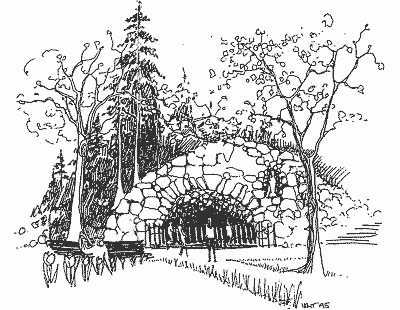
Another heartwarming improvement to the Grotto occurred the year following the 1958-59 Lourdes celebration. No story about the Grotto would be complete without the personal expression of this former student whose memory will always be associated with the Notre Dame Grotto. It became the most celebrated Grotto experience in Notre Dame history.
It arrived on campus in the form of a letter of fond remembrance written by Dr. Tom Dooley and sent to Father Theodore Hesburgh on December 2, 1960 shortly before his death. In his letter Dooley spoke of "that something else that is there" that can "make us sing inside." He died of cancer on January 18, 1961 a month after he wrote to Fr. Hesburgh.
More than one visitor to the Grotto has discerned his religious vocation there. And at least one student, after reading Tom Dooley's letter, decided to become a third world doctor. Over the years, it has been a loving inspiration to many who pause to read it. These two paragraphs of explanation accompanied the distribution of his original letter:
Dr. Thomas A. Dooley, '48 died on the evening of January 18 in a New York hospital. Five days before his death he was visited by Father Hesburgh, who relayed his request for prayers back to the Notre Dame campus. "The Splendid American" died just as the Notre Dame student body had completed three days of prayer in his behalf. A Solemn Mass of Requiem was celebrated for him January 20 in Sacred Heart Church.
In December Father Hesburgh had received a letter from Hong Kong, where Tom Dooley had been hospitalized for a recurrence of cancer that had attacked his spine. An eloquent expression of the faith that had overcome his terrible suffering and prompted his labors in Southeast Asia, a moving tribute to his beloved Notre Dame, the letter was distributed by Associated Press and printed throughout the world after Dooley's death.
Later, a duplicate of the letter, engraved on stainless steel and enclosed in a box with a Plexiglas top, was attached, by Fr. Hesburgh, to the kneeling rail of the Grotto to inspire future generations.
In January of 1986 and April 19, 1993, the campus newspaper the Observer , listed the honors he had received:
Dr. Thomas A. Dooley, III, '48, won world-wide recognition when he brought medical relief to Southeast Asians during the 1950s. He was presented with numerous humanitarian awards, including the Congressional Medal of Honor, the Legion of Merit Award and the National Award of Vietnam, the country's highest honor bestowed upon a foreigner. He was revered for decades by hundreds of thousands of Vietnamese. He also received commendations from Presidents Dwight Eisenhower, John Kennedy, the United States Congress and Pope Pius XII, and was the recipient of the first World Humanitarian Award. Dooley inspired President Kennedy to establish the Peace Corps.
In 1960 the Gallup Poll found him to be among the top ten most admired Americans. That year when his alma mater presented him with an honorary degree, President Eisenhower, the commencement speaker, left his seat to congratulate Dr. Dooley. He said, "Few if any men that I know have equaled his example of complete self-sacrifice, faith in his God, and readiness to serve his fellowmen."
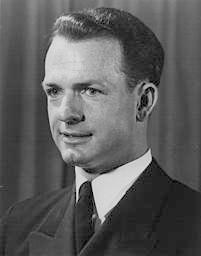
Tom Dooley was born on January 17, 1927 and died the day after his 34th birthday, on January 18, 1961, just six weeks after his December 2, 1960 letter was written from Hong Kong. In it, he speaks of the comfort of prayer. In part:
. . . Because I can pray, I can communicate. How do people endure anything on earth if they cannot have God?
I realize the external symbols that surround one when he prays are not important. . . . It is the Something else there that counts.
But just now . . . and just so many times, how I long for the Grotto. Away from the Grotto Dooley just prays. But at the Grotto, especially now when there must be snow everywhere and the lake is ice glass and that triangular fountain on the left is frozen solid and all the priests are bundled in their too-large too-long old black coats and the students wear snow boots. . . . if I could go to the Grotto now then I think I could sing inside. I could be full of faith and poetry and loveliness and know more beauty, tenderness and compassion . . . .
An exact copy of Dooley's letter is quoted at the end of this story. It was placed at the Grotto four months after his death. Father Hesburgh assigned the project to Rev. Robert Lochner, C.S.C., who engineered the actual placement of the letter. A close examination of Dooley's letter, and the box it is contained in, shows the care taken in planning it. The container is not only durable, it has weathered the many years it had been there with no sign of leakage.
Dooley's family donated many of his souvenirs from his service in Asia to the University of Notre Dame. They are on display in a special Tom Dooley Room in the LaFortune Student Center.
In 1959, a year and six months before his letter to was sent to Fr. Hesburgh, Tom Dooley wrote another poignant letter in which he mentioned the Grotto. It is in the Tom Dooley collection in the University of Notre Dame Archives. He wrote it in reply to a letter sent to him by a man in Elkhart who had gone to premed school with him. Tom apologized for his delay in replying and mentioned that he answered 600-2000 letters a month. He concluded the letter, from the Village of Muong Sing, with this reference to the Notre Dame Grotto:
Oh, to be able to get on my knees in the Grotto of Our Lady just now! I know that God is everywhere. He's everywhere here. We see him daily in 100 wretched who come to the clinic. We see him in the mountains. We see him in the monsoon rainfall on the thatched roof. We know Him when he outstretches His arm in the thunder. But to be in the grotto at Notre Dame; there I find propinquity. There I have nearness that no rationalization can replace.
Village of Muong Sing Kingdom of Laos May 25, 1959
It is said that getting close to nature is getting close to the beautiful, and getting close to the beautiful is getting close to God. Throughout the years since its dedication in 1896 many lovely descriptions of the newly erected Grotto appeared in the Scholastic:
The tall maples in the hollow, near the entrance to the Grotto are shedding their brown leaves and when the sun shines, cast ghostly shadows upon the rocky sides of the Grotto's walls. The place is fitted to inspire serious thought, and if you go there during the day you will find many kneeling in supplication on the rude benches before Mary's statue.(318)
Father Boehm, a seminarian at Holy Cross Hall during the 1920s remembers serving tables in the South Dining Hall at layman retreats during the last weekend in August. On the last day of retreat a conference was conducted at Sacred Heart Church and ended after dark. It was concluded with a huge candlelight procession, which would wind its way from the front door of the church past Corby Hall and along the lake road to the Grotto for benediction. He said it was a very impressive sight with as many as a thousand participants and people watching. I found this many people hard to envision until I learned that the Sacred Heart Church itself has a capacity of 1,235 people and early annual May celebrations at the Grotto often included most of the student body.
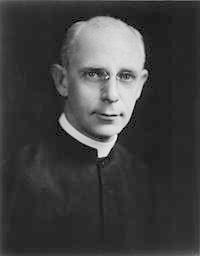
|
Father Hope in his book, Notre Dame -- One Hundred Years, describes Father John F. O'Hara, later Cardinal Archbishop O'Hara, as a superb Prefect of Religion, an office he exercised without interruption from 1918 until he was made president in 1934. He explained his duties as Prefect. The Prefect of Religion is without any disciplinary authority. He cannot suspend or expel students, he cannot punish them. He has no authority in strictly scholastic problems. His work lies in the hearts and minds of the students. He acts as the guide and counselor of their conscience. And the students know this. There is, about his office, all the secrecy and sanctity of the confessional. So the students are more ready to listen to his advice and his encouragement.(319) |
According to his wife, Teresa, another admirer of Father John O'Hara, during his years as Prefect of Religion, was Frederick Snite. She said her husband also spoke of him as a spiritual presence on the campus and a great inspiration to the students.
In the late 1920s and early 1930s under the direction of Rev. John F. O'Hara the Grotto became a spiritual rendezvous for the student body. He had notes, which later evolved into daily religious bulletins, put under the doors of students to remind them to go to the Grotto to pray. Students called them letters from God. In one of those bulletins dated, June 1, 1925, Father John O'Hara leaves one of his reminders.
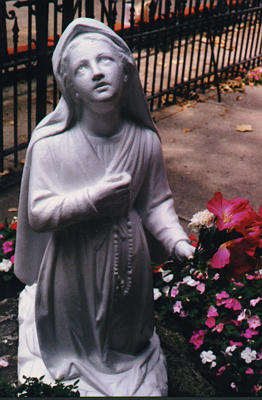
A year ago Ralph Adams Cram [who later designed the South Dining Hall] stated that the grotto is the best piece of art at Notre Dame. Aside from its artistic value, many a student has found it the most inspiring place on the grounds. If you neglected it during the month of the Blessed Virgin, you still have a week in which to learn its beauties and its inspiration. Drop down there after Holy Communion: call again before you go to bed at night. Stand back far enough to see the dome and statue towering over it; then approach and kneel before the statue. The girlish figure in white built this school. On your knees thank the Blessed Virgin for Notre Dame. The old boys who amount to something want to visit the grotto when they come back here; you will in your own good time if you learn its secret while you are here.(320)
Rev. Eugene P. Burke, C.S.C. describes the Grotto during those times:
Fairly large groups visited the Grotto in the spring and early summer before retiring for the night. They could be found there in little knots on their way to and from class and frequently in the month of May in the evening as many as a thousand to fifteen hundred gathered at the foot of Our Lady of Lourdes to sing a few hymns and recite the Salve Regina.
Our Lady on the dome has looked down on the activities of the campus and has been an inspiration and source of encouragement to thousands of students and professors who have lifted their eyes heavenward as they passed over the network of pathways on the campus.
The new college building erected in 1865 was crowned with a small dome and statue of the Mother of God, a new autograph of Notre Dame's faith in Mary. Notre Dame, its spirit and life were but the reflection of its devotion to the Lady on the Dome. The same spirit and devotion to the Mother of God which marked its beginning and has overshadowed it with blessings through all its years.
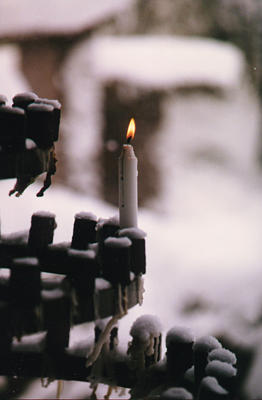
How far this little candle lighted in the snowy wastes of Lac Ste. Marie over a hundred years ago throws its light.(321)
A later, 1939 Scholastic, under the heading, "White December Finds Grotto In Usual Mood" describes a wintertime scene at the Grotto:
And now it is December. The trees that shade her in summer, yawn their nakedness into the cold blue sky. Mossy beds of flowers that usually stretch over the rocks to her niche are tangled dry weeds. The Cracking coldness of the season numbs the iron kneelers at her feet and causes lighted candles beyond to sputter and jump casting leaping shadows on the Grotto walls. But she is not alone. Even when the heavy snow will bury the weeds and clutch the tree trunks she will not be without visitors.
These Grotto visits are more than tradition at Notre Dame. They are an essential part of her life. Students cannot fail to come to this shrine of Our Lady that was erected so they can stop by at any time to offer her their problems or just to say 'hello'(322)
The Dome underscores the above description with this lovely wintertime perception:
It catches the last rays of the setting sun and its snows are the whitest white of winter.
Proof of the sincerity of this devotion to Mary can be seen on any inclement evening when there are still hundreds making the trek to the Grotto to make their day complete. Private visits to the Grotto afford an excellent opportunity to pause for a moment during the day, perhaps to light a candle and speak to Mary about one's problems and decisions.(323)
In 1981, Father Joseph Champlin, speaks of returning to his alma mater and the two days he spent at a conference on "that magnificently beautiful campus." He tells of the morning he walked over to the Grotto:
There I prayed the rosary, recalled moments decades earlier, watched persons stop for a visit and wondered how many million, not thousands, had paused for a similar plea to our Lady since the shrine's erection at the turn of this century.
The stone vault of the cave was blackened from the smoke of past and present votive candles -- over 1,000 were flickering on the morning of my stay at the shrine. A single flower here, a bouquet there speak silently about individual testimonies of affection for our Lady.
Nor is devotion to God's mother at the Grotto merely a carry over from the past with no appeal for the young. During my 7:30 a.m. visit a great cross section of people passed by and paused for prayer. They included a retired Holy Cross religious brother, workmen in overalls, well dressed secretaries, professors with briefcases and several University girls who after their jog around the two small lakes knelt for a long period of time before our Lady. The last visitors symbolized for me the other 8,000 students at Notre Dame of whom many, probably most, and perhaps all have regularly or occasionally honored Mary by their presence at the Grotto.
He also mentions "the handsome marble lectern and altar at one side of the cave and the sign reminding visitors that rosary devotions are conducted every night at 6:45."(324)
It was Father McDonagh who started the rosary at the Grotto, nobody remembers when. He conducted the rosary there twice a year in May and October for a number of years. Nor does anyone remember when Brother John Lavelle started the 6:45 nightly rosary. However, Father Champlin's article indicates that it was a practice in 1981 and probably even before that time.
Father Edward O'Connor conducts the nightly 6:45 rosary, currently, and has for a number of years.
There is no denying that for everyone who views it, there is a mystifying aura of rest and peace associated with this picturesque shrine tucked into the ever changing pastoral scene surrounding it. As someone has said, it is a "favorite walking, resting and meeting place" for countless students, religious and visitors coming and going on the campus. Many non-Catholics visit it regularly and find it a favorite place to meditate, among them a Jewish businessman and a Buddhist student. Truly, it is a place of charm and enchantment for all seasons, a pleasing and artistic adaptation to its surroundings.
